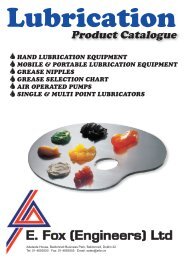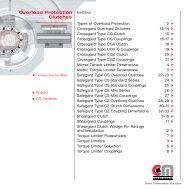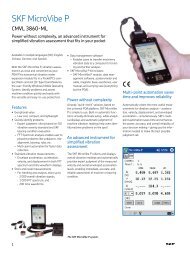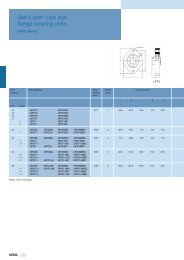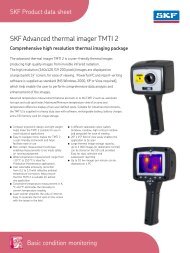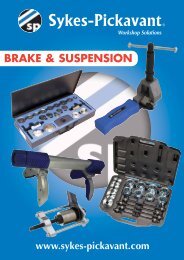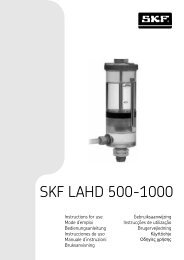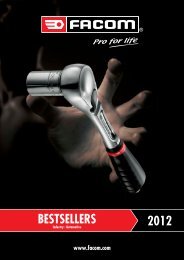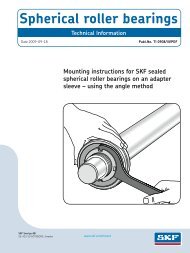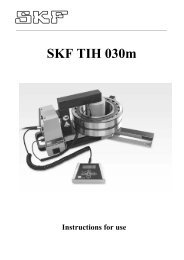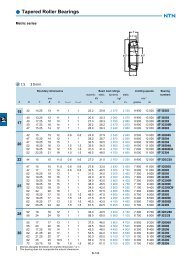PDF catalog - Who-sells-it.com
PDF catalog - Who-sells-it.com
PDF catalog - Who-sells-it.com
Create successful ePaper yourself
Turn your PDF publications into a flip-book with our unique Google optimized e-Paper software.
Roller Chain Drive Design<br />
CROSS+MORSE<br />
• Shafts Centre Distance<br />
For optimum chain life shaft centres w<strong>it</strong>hin the range 30 to 50<br />
times chain p<strong>it</strong>ch should be used, refer to page 9. Drives w<strong>it</strong>h<br />
centres up to 80 times p<strong>it</strong>ch will perform satisfactorily<br />
providing adequate adjustment of chain tension is available.<br />
For very long centres, consideration should be given using two<br />
stage drive w<strong>it</strong>h idler, or alternatively for lightly loaded, slow<br />
speed (up to 1 m/s) drives, supporting both strands of chain on<br />
chain guides.<br />
Long Centre Drive using<br />
Supporting Guides<br />
• Centre Distance Adjustment<br />
When designing a chain drive abil<strong>it</strong>y to adjust the pos<strong>it</strong>ion of<br />
one shaft to <strong>com</strong>pensate for chain wear, should be included,<br />
ideally equal to a minimum of 2 p<strong>it</strong>ches of chain. If this is not<br />
possible, correction for chainwear can be achieved by the<br />
incorporation of adjustable idler or sprung loaded tensioner on<br />
the slack strand of the chain. Automatic adjustment for chain<br />
wear is re<strong>com</strong>mended for drives w<strong>it</strong>h an inclination of more<br />
than 60˚ to the horizontal, see sketch. Idler or tensioner<br />
sprockets should be applied to the outside of the unloaded<br />
strand of the chain close to the driven sprocket, but allowing at<br />
least 5 p<strong>it</strong>ches free length of chain between idler and sprocket<br />
at all times. Ideally at least 3 p<strong>it</strong>ches of chain should engage<br />
w<strong>it</strong>h idler sprockets. Automatic tensioners cannot be used on<br />
reversing drives, or applications where high torque reversals<br />
could be encountered. Idlers also are not generally su<strong>it</strong>able for<br />
reversing drives.<br />
Multi-shaft Drives<br />
Typical Serpentine Drive<br />
Drive to 7 pairs rollers in film process m/c<br />
Roller Chain is often used to connect a number of shafts w<strong>it</strong>hin<br />
one drive. Three arrangements are most <strong>com</strong>mon.<br />
Serpentine drives have the chain laced through a number of<br />
sprockets, so that some can be driven contra-rotation to the<br />
others.<br />
These drives suffer high rates of wear due to the number of<br />
sprockets involved, and <strong>com</strong>bined w<strong>it</strong>h necessary Power Transmission long chainSolutions<br />
length require inclusion of an idler w<strong>it</strong>h a lot of adjustment,<br />
w<strong>it</strong>hin the drive. Sometimes a number of adjustable idlers are<br />
used.<br />
Useful formulae: The following formulae can be used in the Design and Selection of Chain Belt Drives.<br />
Power (kW) = Torque Nm x rev/min<br />
9550<br />
Belt/Chain Speed (M/sec) = Z x p x r.p.m.<br />
60,000<br />
6<br />
Light live roller conveyor drives can be powered using a single<br />
loop of chain w<strong>it</strong>h sprockets running on top. The chain should<br />
be supported on plastic chain guide to maintain constant<br />
contact w<strong>it</strong>h sprockets, alternatively where rollers are well<br />
spaced idler sprockets can be pos<strong>it</strong>ioned oppos<strong>it</strong>e between<br />
each pair of sprockets, this increasing the angle of contact on<br />
the driven sprockets. The small contact between driven<br />
sprocket and chain requires that torque on any one roller<br />
should never exceed 15% of rated power for the drive. Chain<br />
speed should never exceed 1 m/s. An advantage of this layout<br />
is that the driven sprockets and shafts can be easily removed.<br />
Powered live roller conveyors usually have the rollers<br />
connected by coupled simple drives, often w<strong>it</strong>h the use of<br />
double simple sprockets. To keep chain loads to a minimum <strong>it</strong><br />
is preferable to connect input drive to centre roller, this<br />
keeping wear to a minimum. A simple chain drive operates<br />
w<strong>it</strong>h an efficiency of 98%, therefore an allowance of 2% should<br />
be made for power loss in each loop of chain in determining<br />
chain selection and drive motor requirements.<br />
• Elevated Temperature and Stainless Steel<br />
Chains<br />
Standard Roller Chain loses some of <strong>it</strong>s performance capabil<strong>it</strong>y<br />
at elevated temperatures, and also is more prone to corrosion<br />
problems. Hardness of pins and bushes be<strong>com</strong>e reduced<br />
affecting operating life. At temperatures over 170˚C chain drive<br />
capac<strong>it</strong>y is reduced, and this must be included in drive<br />
selection by applying the factor f3 from the table below.<br />
Standard Chain should not be used in temperatures over<br />
250˚C. For elevated temperature applications <strong>it</strong> is preferable to<br />
select Stainless Steel Chains, w<strong>it</strong>h standard series su<strong>it</strong>able on<br />
applications to 325˚C, and 300 series chain for temperatures to<br />
500˚C Stainless Steel Chain has lower wear resistance at all<br />
temperature, and therefore factor f3 in table blow should be<br />
applied when making chain selection.<br />
Factor f3 (Stainless and Elevated Temperature)<br />
Temperature<br />
-5 to 170˚C<br />
170 to 200˚C<br />
200 to 250˚C<br />
250 to 325˚C<br />
325 to 425˚C<br />
425 to 500˚C<br />
Standard Roller Chain Stainless Roller Chain 300 Series Stainless<br />
1.0<br />
1.35<br />
2.0<br />
–<br />
–<br />
–<br />
Z = No. Teeth in Sprocket or Pulley<br />
p = Belt/Chain p<strong>it</strong>ch mm<br />
2.0<br />
2.3<br />
2.6<br />
2.75<br />
–<br />
–<br />
2.6<br />
2.75<br />
2.9<br />
3.2<br />
4.0<br />
5.0<br />
Further design formulae and conversion tables are provided<br />
in the <strong>catalog</strong>ue appendix.<br />
T el +44 121 360 0155 Fax +44 121 325 1079 Email sales@crossmorse.<strong>com</strong><br />
CD Contents<br />
Catalogue Selection INDEX<br />
Transmissions :<br />
INDEX<br />
BACK<br />
NEXT




